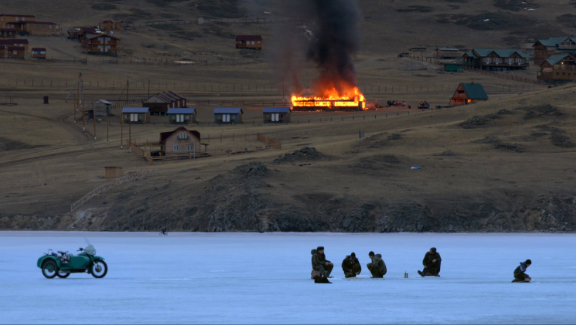Aquarela
Director/ Viktor Kossakovsky
Watched in Theaters
Rating 2.5/5
With Aquarela, director Viktor Kossakovsky may have invented a brand-new documentary genre: climate chaos porn. With its diamond hard icebergs, its velvety black bodies of water, and its spasms of ocean spraying the camera lens, the cumulative torrential effect of all that liquid is positively orgiastic. But while the imagery is busy pleasuring itself in a kind of seductive sadomasochistic bath, it forgets to ground the viewer with any kind of context.
Gradually, yes, you become aware that the director means to preview what it will look and feel like once all the planet’s ice melts and the seas boil and the cataclysmic hurricanes drown our cities, but getting to that apocalyptic climax is a curiously desultory narrative experience. In fact, there is no narrative at all, nothing but a series of puzzling encounters with ice, oceans, and floods.
This is a film meant to be read about before seen. If you’re so inclined, here’s the link that explains where the film is shot and what is the driving vision behind it (specifically, that the main character is an elemental force of nature, water, in all of its dangerous beauty). Humans are no match for water’s destructive power, Kossakovsky wants to tell us. But then why do so many of his lengthy scenes tend toward monotony rather than terror?
The film begins on frozen Lake Baikal (but you won’t know this from watching the film) where there seems to be an epidemic of cars and their drivers falling through ice that should still be frozen enough to drive across. It’s a weirdly inert way to begin the movie, coming across as a kind of teaser for what’s to come, but it’s confusing and more than a little comic before it turns, suddenly, rather tragic.
Next, we’re in Greenland (I think; again, no onscreen locators allowed!) where we watch shot after shot of gigantic ice cliffs calving into the sea. This induces a kind of stupor, since every image is barely distinguishable from the one before it. There are a few cutaways to a nearby village that looks bucolic, inviting, and fragile, but these scenes are also utterly unexplained. In one shot a driverless boat seems to be turning in circles amid ice floes, a man rings an alarm bell on a hilltop, and then the films cuts to…Scotland? Portugal? The middle of nowhere? All we know is we’re now confined on a fancy sailboat in a roiling sea thankfully manned by some very capable looking young sailors. You hang on for the ride, but if you are meant to feel a sense of approaching calamity, it never arrives. In fact, we leave the boat before it arrives anywhere either.
After an hour of these bewildering scenes–and a sequence of monstrous waves crashing on a shore somewhere–the film finally begins to make some sense as we are thrust into the middle of Hurricane Irma ravaging the streets of Miami (we learn the location only after reading about it; do your homework!). It’s a marvel how the director and his crew managed to get serene, stable shots in the middle of a horrifying storm, and you come to appreciate that–when Mother Nature finally tires of our human silliness–she will surely kick our ass.
But then Kossakovsky ends the film ambiguously with a shot of Venezuela’s Angel Falls (see link above) straight out of a tourism video. What are we to make of that? How does it fit into the film’s wordless journey from the melting ice caps to the flooding of our sea level cities? I guess I better keep reading.
If this is meant to be porn, Kossakovsky certainly has the chops for it. Like all pornography, it’s repetitive and ultimately boring. But unlike pornography, this movie wasn’t made on the cheap. Aquarela cost 2.6 million dollars and yet still couldn’t deliver a money shot.

